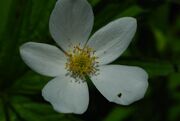Biology:Anemone canadensis
| Anemone canadensis | |
|---|---|

| |
| Scientific classification | |
| Kingdom: | Plantae |
| Clade: | Tracheophytes |
| Clade: | Angiosperms |
| Clade: | Eudicots |
| Order: | Ranunculales |
| Family: | Ranunculaceae |
| Genus: | Anemone |
| Species: | A. canadensis
|
| Binomial name | |
| Anemone canadensis | |
| Synonyms[1] | |
| |
Anemone canadensis, the Canada anemone, round-headed anemone, round-leaf thimbleweed,[2] meadow anemone, windflower,[3] or crowfoot, is a herbaceous perennial native to moist meadows, thickets, streambanks, and lakeshores in North America, spreading rapidly by underground rhizomes, valued for its white flowers.[4] It is sometimes called Anemonastrum canadense.[5]
Description
The Canada anemone has shoots with deeply divided and toothed basal leaves on 8–22 cm (3 1⁄4–8 3⁄4 inches). They grow from ascending caudices on long, thin rhizomes. The shoots are 20–80 cm (8–31 inches) tall, and leaves are 4–10 cm (1 1⁄2–4 inches) by 5–15 cm (2–6 inches).[6]
Flowers with about 5 white, petal-like sepals and 80-100 yellow stamens bloom from late spring to summer on stems above a cluster of leaves. The sepals are obovate (with the base slightly tapered) and 10–20 mm (1⁄2–3⁄4 inch) by 5–15 mm (1⁄4–5⁄8 inch).[6]
When they are pollinated, the green pistils in the middle of the flower become a rounded to slightly lengthened seed head. The seeds are achenes, with an almost round body and a beak.[6]
Uses
In former times it was used medically by North American Indigenous peoples as an astringent and as a styptic for wounds, sores, nosebleeds, and as an eyewash. The root was respected by Plains tribes and used for many ailments.
Toxicity
It is likely that most anemones contain the caustic irritants of the family Ranunculaceae.[7]
References
- ↑ "Anemone canadensis", Tropicos, Missouri Botanical Garden, http://www.tropicos.org/NameSearch.aspx?projectid=&name=Anemone+canadensis, retrieved 2019-06-26
- ↑ Native Plant Database profile, Lady Bird Johnson Wildflower Center, University of Texas at Austin
- ↑ Missouri Botanical Garden
- ↑ Nathaniel Lord Britton, Addison Brown (1913). An Illustrated Flora of the Northern United States, Canada and the British Possessions: From Newfoundland to the Parallel of the Southern Boundary of Virginia, and from the Atlantic Ocean Westward to the 102d Meridian. 2. C. Scribner's sons. https://books.google.com/books?id=RZUCAAAAYAAJ. page 99
- ↑ Mosyakin, S.L. (2016). "Nomenclatural notes on North American taxa of Anemonastrum and Pulsatilla (Ranunculaceae), with comments on the circumscription of Anemone and related genera". Phytoneuron (79): 1–12. ISSN 2153-733X. https://www.phytoneuron.net/2016Phytoneuron/79PhytoN-Anemonastrum.pdf.
- ↑ 6.0 6.1 6.2 Dutton, Bryan E.; Keener, Carl S.; Ford, Bruce A. (1997), "Anemone canadensis", in Flora of North America Editorial Committee, Flora of North America North of Mexico (FNA), 3, New York and Oxford, http://www.efloras.org/florataxon.aspx?flora_id=1&taxon_id=233500051, retrieved 24 October 2016
- ↑ Foster, Steven and James A. Duke. Eastern/Central Medicinal Plants, "Peterson Field Guides", Houghton, Mifflin 1990 edn. ISBN:0-395-92066-3
Wikidata ☰ Q2198861 entry


